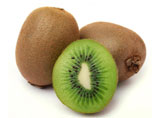
Kiwifruit may be eaten raw, made into juices, used in baked goods, prepared with meat or used as a garnish. The whole fruit, including the skin, is suitable for human consumption; however, the skin is often discarded due to its texture. Sliced kiwifruit has long been used as a garnish atop whipped cream on pavlova, a meringue-based dessert. Traditionally in China, kiwifruit was not eaten for pleasure but was given as medicine to children to help them grow and to women who have given birth to help them recover.
Nutrition
In a 100-gram amount, green kiwifruit provides 61 calories, is 83% water and 15% carbohydrates, with negligible protein and fat (table). It is particularly rich (20% or more of the Daily Value, DV) in vitamin C (112% DV) and vitamin K (38% DV), has a moderate content of vitamin E (10% DV), with no other micronutrients in significant content. Gold kiwifruit has similar nutritional value, although only vitamin C has a high content in a 100-gram amount (194% DV, table).
The kiwifruit seed oil contains on average 62% alpha-linolenic acid, an omega-3 fatty acid. Kiwifruit pulp contains carotenoids, such as provitamin A beta-carotene, lutein, and zeaxanthin.
Production
In 2017, global production of kiwifruit was 4.04 million tonnes, led by China with 50% of the world total (table). Italy, New Zealand, Iran, and Chile were other major producers. In China, kiwifruit is grown mainly in the mountainous area upstream of the Yangtze River, as well as Sichuan.
Kiwifruit production – 2017
| Country | Tonnes |
|---|---|
| China | 2,024,603 |
| Italy | 541,150 |
| New Zealand | 411,783 |
| Iran | 311,307 |
| Chile | 224,916 |
Storage
Fruits harvested when the firm will ripen when stored properly for long periods. This allows fruit to be sent to market up to 8 weeks after harvest.
Firm kiwifruit ripen after a few days to a week when stored at room temperature, but should not be kept in direct sunlight. Faster ripening occurs when placed in a paper bag with an apple, pear, or banana. Once a kiwifruit is ripe, however, it is preserved optimally when stored far from other fruits, as it is very sensitive to the ethylene gas they may emit, thereby tending to over-ripen even in the refrigerator. If stored appropriately, ripe kiwifruit normally keep for about one to two weeks.






